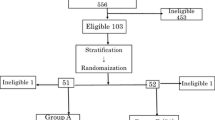Summary
The nonspecific macrophage-mediated antitumour effects resulting from IV C. parvum (CP) in mice were resistant to cyclophosphamide (CY), whereas the specific T cell-mediated immunity resulting from SC injection of CP-irradiated tumour cell mixtures was sensitive for up to 8 days after immunisation, and resistant thereafter. Mice with solid fibrosarcoma (M4) were treated by IV CP followed by CY and, with intervals between CP and CY of 1–4 and 15–18 days, the antitumour effects of the CY were potentiated in a ‘synergistic’ manner. This did not happen with 8- or 12-day intervals. The most potent antitumour effects (39% complete regressions) occurred with the 15–18 day interval. (The antitumour activity of another alkylating agent, melphalan, was similarly potentiated when given 12–18 days after IV CP, but not after 4 days.) No potentiated antitumour effects were found when specific active immunotherapy with CP-irradiated tumour cell mixtures preceded CY by 1, 4, 8, 12, or 18 days. CP given IV increased the susceptibility of mice to subsequent high doses of CY, the peak sensitivity being around 10 days after CP.
Similar content being viewed by others
References
Fisher, B., Rubin, H., Saffer, E., Wolmark, N.: The effect of Corynebacterium parvum in combination with 5-fluorouracil, l-phenylalanine mustard or methotrexate in the inhibition of tumour growth. Cancer Res. 36, 2714 (1976a)
Fisher, B., Wolmark, N., Rubin, H.: Further observations on the inhibition of tumour growth by Corynebacterium parvum with cyclophosphamide. III. Effect of C. parvum on cyclophosphamide metabolism. J. Natl. Cancer Inst. 57, 225 (1976b)
Foster, R. S.: The effects of Corynebacterium parvum on granulocyte/macrophage production and toxicity of chemotherapy. Dev. Biol. Stand. 38, 245 (1978)
Hattori, T., Yamagata, S.: Combined treatment with anaerobic Corynebacterium liquefaciens and chemotherapeutics against solid tumours in mice. Gann 68, 115 (1977)
Israel, L., Edelstein, R.: Non-specific immunostimulation with C. parvum in human cancer. In: Immunological Aspects of Neoplasia, p. 485. Baltimore, Md.: Williams and Wilkins 1975
Macnee, C. M., Nimmo-Smith, R. H.: Effects of Corynebacterium parvum vaccine on drug metabolism in the mouse. Dev. Biol. Stand. 38, 427 (1978)
Milas, L., Scott, M. T.: Anti-tumour activity of Corynebacterium parvum. Adv. Cancer Res. 26, 257 (1978)
Olivotto, M., Bomford, R.: In vitro inhibition of tumour cell growth and DNA synthesis by peritoneal lung macrophages from mice injected with Corynebacterium parvum. Int. J. Cancer 13, 478 (1974)
Scott, M. T.: Corynebacterium parvum as a therapeutic anti-tumour agent in mice. I. Systemic effects from intravenous injection. J. Natl. Cancer Inst. 53, 855 (1974)
Scott, M. T.: Conditions favouring the selection of either specific or non-specific C. parvum-mediated non-specific anti-tumour immunity in mice. Dev. Biol. Stand. 38, 273 (1978)
Scott, M. T.: Analyses of the principles underlying the chemo-immunotherapy of mouse tumours. I. Treatment with cyclophosphamide followed by Corynebacterium parvum. Cancer Immunol. Immunother (in Press, 1979)
Soyka, L. F., Hunt, W. G., Knight, S. E., Foster, R. S.: Decreased liver and lung drug-metabolising activity in mice treated with Corynebacterium parvum. Cancer Res. 36, 4425 (1976)
Tagliabue, A., Pozentarutti, N., Vecchi, A., Mantovani, A., Spreafico, F.: Combination chemo-immunotherapy with adriamycin in experimental tumour systems. Eur. J. Cancer 13, 657 (1977)
Tuttle, R. L., North, R. J.: Mechanisms of anti-tumour action of Corynebacterium parvum: replicating short-lived T cells as mediators of potentiated tumour specific immunity. J. Reticulendothel. Soc. 20, 209 (1976)
Author information
Authors and Affiliations
Rights and permissions
About this article
Cite this article
Scott, M.T. Analysis of the principles underlying chemo-immunotherapy of mouse tumours. Cancer Immunol Immunother 6, 113–119 (1979). https://doi.org/10.1007/BF00200140
Accepted:
Issue Date:
DOI: https://doi.org/10.1007/BF00200140




